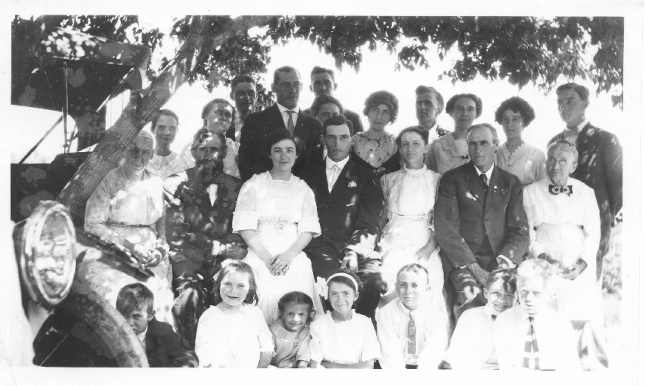| Feature Story October 2003 “True Stratton and Rueben Ulmer Wedding Day, June 16, 1915″ (written by their oldest daughter, Evelyn Ulmer, upon the observance of the couples 50th wedding anniversary, June 16, 1965) |
| It was a beautiful wedding day, cool and bright, a day much like today (1965). There was rain the day before and the day after. The wedding took place at the home of the bride in Brownville, high on a hill over looking the town and the Missouri River, which was bank full from the rains. The bride had taught 40 pupils in the primary room at Dawson for two years, walking a mile to school and back. At the end of the school year she went to the Brownville home of her parents to sew her wedding dress and plan the wedding. During the winter of 1914 the groom had dug a well on the farm two miles north of Dawson, built a big hay and stock barn, a chicken house for the 24 hens his mother gave him. In the early spring of 1915 he and a carpenter began work on the house. Automobiles were few, so it was most unusual for the groom to make so long a trip. His brother Nelson drove him to Brownville. It was the farthest he had been from home, in his 22 years as he had only been to Falls City twice in his lifetime to that date. He arrived in Brownville on Sunday. On Monday and Tuesday he helped pick strawberries and made a daylong trip with the bride’s father to Auburn by train for the marriage license. The wedding was on Wednesday, a simple ceremony at noon, followed by a dinner. Guests were parents, brothers and sisters and their families, the bride’s grandmother, and the Rev. H. S. Tool. The Dawson minister performed the ceremony! On Wednesday evening the guests returned home in their autos. The bride and groom returned to Dawson by train on Friday, staying a few days at the home of grooms parents, and then went to live in a part of their just enclosed new house. The bride cooked for the carpenters, the groom helped with the building work, reserving much of the finishing work for himself. Now, tall elms, maples and coffee trees surround the house. There are six children, four sons-in-law and thirteen grandchildren. There have been droughts and two world wars since the marriage. The house has survived lightening and a small tornado. The pumping and carrying of buckets of water have changed to a turn of a faucet. The single walking plow and two horses with which Rueben broke the sod on the south twenty are as obsolete as the horse and buggy that took them to church. The autos that could not travel after a heavy rain and were drained and put on blocks for the winter have gone, and now night and day the year around the highway is filled with the noise of cars and thundering trucks. In retirement years True teaches piano and organ, serves as church organist and keeps up a voluminous correspondence with her scattered children and friends. Rueben, a Sunday School Superintendent, orchestra and choir director, spends long days at work as carpenter and painter, a careful and artistic workman. Their concerns have been home, church, and community, and to these they have given themselves generously and well. |

Middle row: Sarah and Emmanuel Ulmer, True and Rueben, Mary and Clarence Stratton, and Grandmother Cynthia Stratton.
Front row: Art Tool, Miriam Wuster, Lucille, Helen, and John Stratton, Orville Wuster, and Eugene Tool